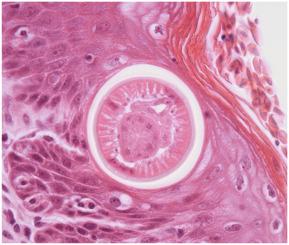International Journal for Parasitology: Parasites and Wildlife ( IF 2.0 ) Pub Date : 2020-10-14 , DOI: 10.1016/j.ijppaw.2020.10.003 Adrienne F. French , Fernanda Castillo-Alcala , Kristene R. Gedye , Matthew A. Knox , Wendi D. Roe , Brett D. Gartrell

|
In 2013 there was an outbreak of crusting ventral dermatitis among a group of juvenile rowi (Apteryx rowi), a species of the endangered New Zealand kiwi, that were being raised on an off-shore island sanctuary. Biopsies taken at the time found nematodes migrating within the epidermis of affected skin but the specific identity and origin of the organisms was not established, and sporadic cases of similar skin disease continue to occur on the island. On examination of additional sections from the original skin biopsies, adult nematodes and eggs were identified, the histomorphology of which was consistent with Capillaria sensu lato. PCR was performed on DNA extracted from archived formalin-fixed, paraffin-embedded tissue blocks of skin from eight affected rowi, using primers targeting the 18S region of nuclear ribosomal DNA and the COI gene of mitochondrial DNA of capillarid nematodes. The 18S sequences from all rowi samples were identical and matched sequences from members of the genus Eucoleus. In contrast, two distinct capillarid COI sequences were obtained, in one case both from the same rowi skin biopsy. While there were no close matches, both COI sequences also aligned nearest to sequences identified as Eucoleus spp. It is considered unlikely that two different nematode species are involved in the rowi skin lesions and the possible amplification of a COI pseudogene or “numt” is discussed. A species-level identification of the capillarid nematodes causing skin disease in rowi was not obtained, however based on histological evaluation the infections include reproductively-active adult nematodes. This finding indicates the possibility of perpetuation of the skin disease in the absence of the original source, as well as raising potential for the transfer of infection from the island when the juvenile rowi are translocated to their new habitats.
中文翻译:

皮肤毛细血管病引起的罗伊腹侧皮炎(Apteryx rowi)
2013年,一群濒临灭绝的新西兰奇异鸟的少年罗威(Apteryx rowi)爆发了结itis性腹侧皮炎,该物种在一个离岛保护区饲养。当时进行的活组织检查发现线虫在受影响的皮肤表皮内迁移,但尚未确定该微生物的具体身份和起源,并且岛上继续发生零星的类似皮肤病病例。在检查原始皮肤活检的其他切片后,确定了成年线虫和卵,其组织形态与毛细血管毛细血管瘤一致。使用从靶向核糖体DNA的18S区和毛细线虫线粒体DNA的COI基因靶向的引物,对来自八只患病罗伊鱼的归档福尔马林固定,石蜡包埋的皮肤组织块提取的DNA进行PCR。来自所有罗威样品的18S序列是相同的,且来自真核属成员的匹配序列。相比之下,在相同的罗维皮肤活检中获得了两个不同的毛细血管COI序列。虽然没有紧密匹配,但两个COI序列的排列也最接近被鉴定为真核生物的序列spp。人们认为在罗威皮肤损伤中不可能涉及两种不同的线虫物种,并且讨论了COI假基因或“ numt”的可能扩增。尚未获得引起罗威性皮肤病的毛细线虫的物种一级鉴定,但是根据组织学评估,感染包括具有生殖活性的成年线虫。这一发现表明,在没有原始来源的情况下,皮肤病可能会长期存在,而且当少年罗威被转移到新的栖息地时,也增加了从岛上传播感染的可能性。











































 京公网安备 11010802027423号
京公网安备 11010802027423号